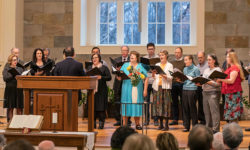Hispanic Heritage Month
October 5, 2021 | Shereka Banton & Beth Sears
What is Hispanic Heritage Month?
National Hispanic Heritage Month celebrates Hispanic American culture and contributions to the United States past and present. Hispanic Heritage Month is celebrated annually from September 15 – October 15. For our post on Hispanic Heritage Month, we wanted to share just how far back into US History Hispanic heritage (i.e., of Spanish-speaking descent) exists.
Why do we designate a month to acknowledge and celebrate Hispanic Heritage?
First, because it is good to recognize the diversity within our country and especially among our church family. Just as our varied gifts and talents come together to make up the church body, likewise our many cultures can expand and enrich our worship and our understanding of how God works through the peoples of the world.
Second, because the contributions of Spain to the formation of Colonial America can be lesser known than those of the British. In fact, the Spanish were the first explorers and settlers of the Americas, including the present-day US.
For instance, did you know?
- Juan Ponce de Leon is credited as the first European to explore the coast of Florida, which he claimed for Spain and named La Florida in 1513.
- Although we hear a lot about the English settlements of Jamestown, Virginia (1607) and Plymouth Massachusetts (1620) as the first settlements in the United States, the Spanish settlement in St. Augustine, Florida (1565) is the first and oldest city in the United States with Santa Fe, New Mexico (1608) being the second oldest.
- From the Diary of Francisco Lopez de Mendosa, Chaplain — Father Lopez describes detail of the landing; Captain Pedro Menendez christened the new settlement St Augustine on Sept 8, 1565. He first kissed the Cross then planted the Spanish flag, by doing so declared it “in name of” God before “in name of” king. Father Lopez conducted a Mass of thanksgiving and Menendez ordered that a meal be prepared for everyone, including the natives –55 years before the Pilgrims even arrived in Plymouth. Historian Dr. Michael Gannon drew criticism when he called this meal “the true first thanksgiving”. (Secrets of Spanish Florida)
- The 1565 marriage in St. Augustine between Luisa de Abrego, a free black domestic servant from Seville, and Miguel Rodríguez, a white Segovian conquistador, is the first known and recorded Christian marriage anywhere in what is now the continental United States.
- St. Augustine was a multicultural city populated by Europeans, Africans, and Native Americans. This was unique to pre Colonial and Colonial America. St. Augustine was also a sanctuary for slaves that escaped the British colonies to the north.
- In 1567 the Spanish began establishing missions in Florida to convert Native Americans to Christianity, to facilitate control of the area, and to prevent its colonization by other countries, in particular, England and France. Spanish Missions were also established in Arizona, California, the Carolinas, Georgia, Louisiana, New Mexico, Texas and Virginia.
- While its boundaries were never clearly or formally defined, Spanish territory was initially much larger than the present-day state of Florida, extending over much of what is now the southeastern United States, including all of present-day Florida plus portions of Georgia, Alabama, Mississippi, the Carolinas, and Louisiana.
- Until 1848 all or part of New Mexico, Arizona, California, Utah, Nevada and Wyoming were part of Mexico.






